By Lucia Mutikani
WASHINGTON (Reuters) - U.S. single-family homebuilding rebounded sharply in August, but a moderate increase in building permits suggested that the momentum was unlikely to be sustained against the backdrop of rising supply of new homes on the market.
The jump in single-family housing starts reported by the U.S. Commerce Department on Wednesday probably reflected the fading drag from Hurricane Beryl, which had depressed homebuilding in the South. Homebuilders could also face a challenge from increasing inventory of previously owned homes for sale, with the U.S. Federal Reserve cutting interest rates by 50 basis points on Wednesday, the first rate reduction since 2020.
Most home owners have mortgage rates below 4%, and higher rates had deterred many from listing their houses. The so-called "rate lock" starved the housing market of supply, creating an opportunity for builders.
"A renewed dip in single-family construction activity is likely over the next few months as homebuilders seem to have responded too aggressively to the slight upturn in new home sales in 2023, and are now left with an excessive level of inventory," said Oliver Allen, senior U.S. economist atPantheon Macroeconomics. "Lower mortgage rates will help boost demand for new homes at the margin."
Single-family housing starts, which account for the bulk of homebuilding, surged 15.8% to a seasonally adjusted annual rate of 992,000 units last month, the Commerce Department's Census Bureau said. Single-family starts rose 5.2% from a year ago.
Permits for future construction of single-family housing increased 2.8% to a rate of 967,000 units. They were down 0.5% from a year ago.
Single-family home building had dropped for five straight months after a surge in mortgage rates in spring curbed home sales, resulting in an oversupply of newly built houses.
A National Association of Home Builders survey on Tuesday showed homebuilder sentiment improved marginally in September after sliding for four consecutive months, but noted that "builders will face competition from rising existing home inventory in many markets as the mortgage rate 'lock-in' effect softens with lower mortgage rates."
Mortgage rates have retreated to 1-1/2-year lows. New housing supply is near levels last seen in early 2008, with the months' supply above the 2018-2019 average.
The rise in supply has, however, been uneven, and affordability remains a constraint that will probably not ease with the reduction in mortgage rates.
Mortgage finance agency Fannie Mae's Economic and Strategic Research group on Wednesday noted that most of the rise in homes for sale has been in the Sun Belt and Mountain West regions, which also experienced some of the strongest home price growth in recent years as well as robust new home construction.
The group said this created both a large relative affordability shock in these states and greater competition for existing home sales stemming from the new construction.
"Although mortgage rates have fallen considerably in recent weeks, we've not seen evidence of a corresponding increase in loan-application activity, nor has there been an improvement in consumer home-buying sentiment," said Doug Duncan, chief economist at Fannie Mae.
"We expect affordability to remain the primary constraint on housing activity for the foreseeable future," Duncan added.
Single-family starts vaulted 18.9% in the densely populated South, where activity was likely weighed down by Hurricane Beryl in July. Starts soared 47.4% in the Northeast and increased 11.6% in the Midwest, which is considered the most affordable region. Homebuilding rose 2.8% in the West.
Stocks on Wall Street were little changed ahead of the U.S. central bank's rate decision. The dollar slipped against a basket of currencies. U.S. Treasury yields rose.
HOUSING DRAG ON ECONOMY
Starts for housing projects with five units or more dropped 6.7% to a rate of 333,000 units in August. Overall housing starts jumped 9.6% to a rate of 1.356 million units. Economists polled by Reuters had forecast starts increasing to a rate of 1.310 million units. Housing starts rose 3.9% from a year ago.
Multi-family building permits shot up 8.4% to a rate of 451,000 units. Building permits as a whole advanced 4.9% to a rate of 1.475 million units. They dropped 6.5% from a year ago.
Economists expected the housing market to have remained a drag on economic growth in the third quarter and extend the decline into the final three months of the year.
"In the single-family market, while sales have held up reasonably well, inventories have nonetheless risen substantially," said Abiel Reinhart, an economist at J.P. Morgan. "Builders may prefer to keep starts low for a time to work off this inventory. Lower mortgage rates could also help reduce single-family inventories via stronger sales. But sales in the new home market have less room to improve."
The number of houses approved for construction that were yet to be started increased 1.4% to 285,000 units last month. The single-family homebuilding backlog rose 2.8% to 148,000 units, the highest level since April 2020. The completions rate for that housing segment dropped 5.6% to 1.029 million units.
Overall housing completions increased 9.2% to a rate of 1.788 million units. The number of housing units under construction declined 1.9% to a rate of 1.509 million units, the lowest level since November 2021.

The inventory of single-family housing under construction dipped 0.3% to a rate of 642,000 units.
"New construction projects will likely not reattain levels reached a few years ago," said Veronica Clark, an economist at Citigroup. "This means that as units under construction continue to be completed and are not offset with an equal number of new construction projects, total construction will decline."